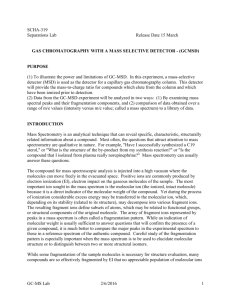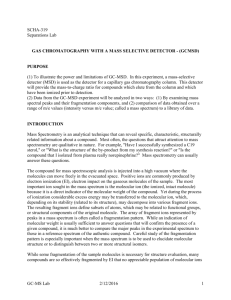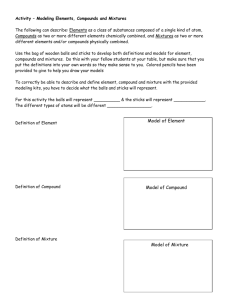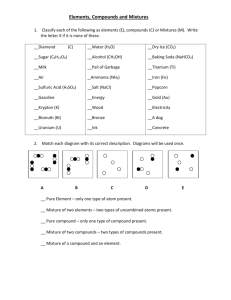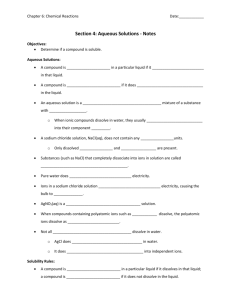GC-MS Lab
advertisement
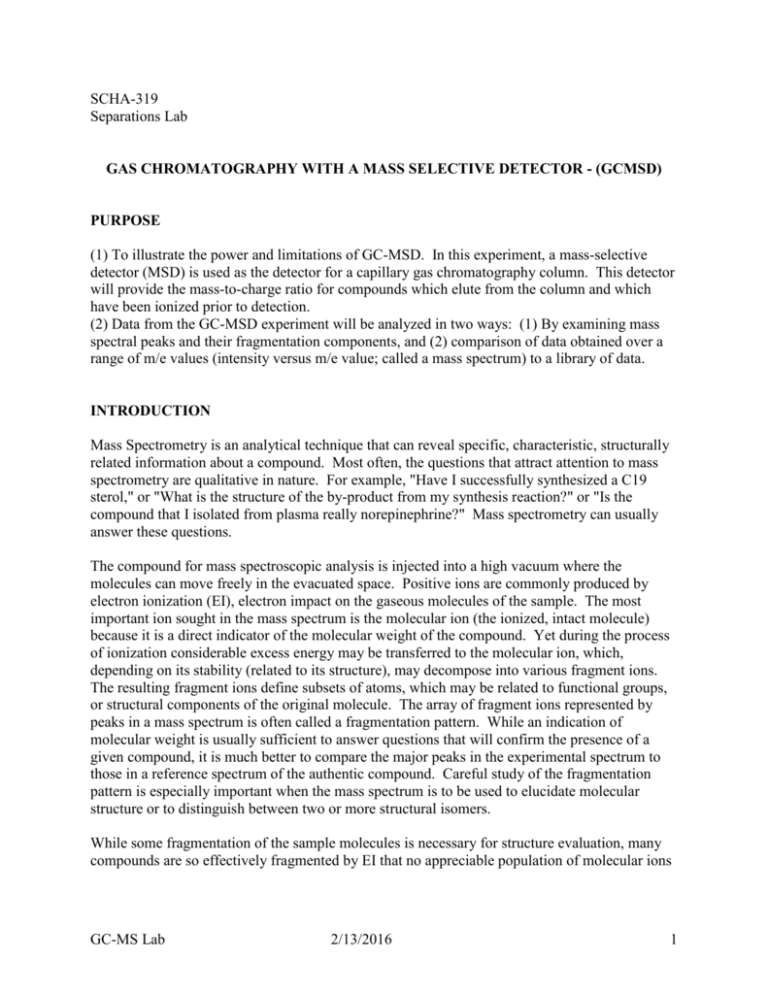
SCHA-319 Separations Lab GAS CHROMATOGRAPHY WITH A MASS SELECTIVE DETECTOR - (GCMSD) PURPOSE (1) To illustrate the power and limitations of GC-MSD. In this experiment, a mass-selective detector (MSD) is used as the detector for a capillary gas chromatography column. This detector will provide the mass-to-charge ratio for compounds which elute from the column and which have been ionized prior to detection. (2) Data from the GC-MSD experiment will be analyzed in two ways: (1) By examining mass spectral peaks and their fragmentation components, and (2) comparison of data obtained over a range of m/e values (intensity versus m/e value; called a mass spectrum) to a library of data. INTRODUCTION Mass Spectrometry is an analytical technique that can reveal specific, characteristic, structurally related information about a compound. Most often, the questions that attract attention to mass spectrometry are qualitative in nature. For example, "Have I successfully synthesized a C19 sterol," or "What is the structure of the by-product from my synthesis reaction?" or "Is the compound that I isolated from plasma really norepinephrine?" Mass spectrometry can usually answer these questions. The compound for mass spectroscopic analysis is injected into a high vacuum where the molecules can move freely in the evacuated space. Positive ions are commonly produced by electron ionization (EI), electron impact on the gaseous molecules of the sample. The most important ion sought in the mass spectrum is the molecular ion (the ionized, intact molecule) because it is a direct indicator of the molecular weight of the compound. Yet during the process of ionization considerable excess energy may be transferred to the molecular ion, which, depending on its stability (related to its structure), may decompose into various fragment ions. The resulting fragment ions define subsets of atoms, which may be related to functional groups, or structural components of the original molecule. The array of fragment ions represented by peaks in a mass spectrum is often called a fragmentation pattern. While an indication of molecular weight is usually sufficient to answer questions that will confirm the presence of a given compound, it is much better to compare the major peaks in the experimental spectrum to those in a reference spectrum of the authentic compound. Careful study of the fragmentation pattern is especially important when the mass spectrum is to be used to elucidate molecular structure or to distinguish between two or more structural isomers. While some fragmentation of the sample molecules is necessary for structure evaluation, many compounds are so effectively fragmented by EI that no appreciable population of molecular ions GC-MS Lab 2/13/2016 1 survives to give an indication of the molecular weight in the mass spectrum. Chemical ionization (CI), involving ionization of the sample molecule by collisions with ions of a reagent gas (for example, the ions produced by electron ionization of methane), is a more "gentle" ionization technique which often produces abundant protonated molecular ions. The resultant spectrum provides a good indication of molecular weight but may have insufficient fragmentation for functional group and structural evaluation. Of course, in order for mass spectrometry to be helpful the ions that are studied must originate from a pure source of the sample of interest, for to consider ions that are unrelated to the compound could be worse than having no mass spectral data at all. It is essential to insure that a sample contains no material that will produce unexpected ions which could interfere with interpretation. Thus, the combination of gas chromatography and mass spectrometry (GCMS) is often the method of choice. The gas chromatograph can separate the compound of interest from other potentially interfering compounds and present it to the mass spectrometer in purified form over a time interval sufficient to obtain the mass spectrum. Per unit quantity of sample, mass spectrometry perhaps delivers more information concerning a molecule than does any other spectroscopic technique. Although mass spectrometry rarely solves a problem "single-handedly", it often provides the critical complimentary data that finally "crack" an identification problem. For a complete identification of a sample compound 0.1 to 1 micrograms of the sample may be required. If all that is needed is detection and verification of the presence of an already-identified compound the sample requirements are less severe (sometimes requiring only femtogram quantities). Although mass spectrometry has been used successfully in the determination of many compounds (usually having a molecular weight of less than 1,000), one consistent obstacle is whether a compound of interest is amenable to vapor phase analysis. However, techniques such as field desorption (where a sample molecule is desorbed from the surface of a probe or electrode as an ion when it enters a high electric field), and chemical derivatization to increase thermal stability and volatility, extend the applicability of mass spectrometry to increasing numbers and types of compounds. Finally it should be noted that there are three basic types of mass sensitive instruments encountered commonly in analytical chemistry laboratories. The first type is the magnetic sector mass spectrometer (see Figure 1). GC-MS Lab 2/13/2016 2 Figure 1: Schematic of sector magnet mass spectrometer The ion stream from the source is passed by a wedge shaped magnet. The ions curve in response to the magnetic field and separate into several ions streams based on their individual trajectories in response to the magnetic field. At any given magnetic field strength (or, accelerating potential) only one stream has appropriate trajectory (based on it m/e value) to successfully survive the curved "track" to the detector. All other ions will collide with the walls of the track or with the detector slits and will not reach the detector to be recorded. It is common to sweep the magnetic field strength at constant accelerating potential to bring the different ion streams to the detector. The magnetic field sweep can be accomplished very quickly and thus an entire mass spectrum, covering a wide m/e range, can be recorded in a short time frame. The second type is the quadrupole device which form a class of non-magnetic mass spectrometers and mass selective detectors (see Figure 2). GC-MS Lab 2/13/2016 3 Figure 2: Schematic of quadrupole design Our HP 5973 Mass Selective Detector is a quadrupole device. It employs a combination of dc and radiofrequency (rf) potentials as a mass "filter". The quadrupole typically consists of 4 cylindrical, parallel rods (10-25 cm in length) situated symmetrically in a square arrangement. Rods diagonally opposite each other are connected, in pairs, to dc and rf generators. Positive ions extracted from the ions source are accelerated into the quadrupole along the longitudinal axis of the four rods. The ions are influenced by the combined dc and rf fields. In order for an ion to reach the detector it must traverse the quadrupole without colliding with any one of the metal rods. For any level of rf/dc voltage only ions of a specific m/e avoid collision and reach the detector. The entire mass spectrum is obtained as voltages are swept from a pre-established minimum to a maximum. In our MSD the rf/dc voltages are stepped in a manner that corresponds to 0.1 amu m/e jumps. Lastly, there are time-of-flight devices which record the time it take for an accelerated ion to travel from the ion source to the detector (see Figure 3). GC-MS Lab 2/13/2016 4 Figure 3: Schematic of time-of-flight mass spectrometer Supplies 1) Alkane mixture 2) Known Mixture (in Pentane) Alkanes Octane Nonane Decane Undecane Dodecane Tridecane Alkenes 1-Octene 1-Nonene 1-Decene 1-Undecene 1-Dodecene 1-Tridecene Alcohols 2-Methyl-1-butanol 1-Hexanol Cyclohexanol 1-Heptanol Benzyl alcohol 1-Octanol Ketones MIBK 2,4-Dimethyl-3-pentanone 2-Heptanone Cyclohexanone Acetophenone 1-Phenyl-1-propanone 3) Unknown Mixture of 3 compounds from the above list 4) Test Solution (Decane in Pentane) GC-MS Lab 2/13/2016 5 Procedure This section includes a number of questions. Answers to these should be included in the report. These may be placed in either the experimental or discussion sections, as considered appropriate. I. Instrument Start-up and Introduction 1) Turn on the computer and monitor. The instrument should already be on. 2) Start an instrument log-book entry. Enter today's date, time, reason for using the instrument. NOTE: Please record anything else of significance that is done to the instrument (septum change, column switch, etc.) or any other problems that occur during operation. 3) Log on to Windows NT using “student” as the user name and password. 4) Double click on the “RIT Chemistry” icon on the “Windows NT desktop”. If it isn’t there, click on “Start”, “Programs”, “RIT Chemistry”, and then “RIT Chemistry”. 5) Click on “Method”, then “Load”. Scroll down until the “SCHA-319.M” method appears. Click on it then click on “OK”. 6) Click on “Method”, then “Edit Entire Method”. Click on “OK” until the “Instrument/Edit/Inlet” screen appears. The Inlet Button is highlighted in yellow. Record the parameters below in your notebook and describe what each means in your lab write up. Click on “OK” after you record these values. a. Split Flow b. Split Ratio c. Total Flow d. Pressure e. Heater Temperature f. Gas g. Calculate the Septum Purge from the above values. h. Also, record the Carrier Gas (He) cylinder pressure and feed pressure (40-60 psig.) 7) Many dialog boxes will be presented. Most of these should be left unchanged (Use the "OK" button). The purpose here is to gain familiarity with the instrumentation. Please consult with the TA if any questions arise concerning any of the information. Use the software help feature to answer the questions concerning these parameters. These should be included in the report. Please make a note of the following critical parameters. a. Solvent Delay = 2.00 min. - What is the purpose of this parameter? b. MS Scan Parameters Mass Range: Low = 20 High = 300 Scans/sec = 3.3. What do these values signify? How are they related? c. Column Information d. Temperature Information (Injection and Mass Detector). e. Oven Program Initial Temperature Setpoint = 50o C, Initial Time = 2.0 min., Final Temperature = 150o C, Final Time = 1.0 min. Make sure that these parameters are correct. There should also be a second line in the temperature program that raises the temperature to 280o C. GC-MS Lab 2/13/2016 6 f. Library Search Parameters - Library Name. II. Tuning the Mass Spec. 1. Click on “View”, and then “Manual Tune”. 2. Click on “Autotune”. What compound is being used? Give the full chemical name, not just the initials. Also what masses are selected for tuning? What fragments does each of these three masses represent? Why must the mass spec be Auto Tuned? 3. When the instrument tune is complete click on “File”, then “Save Tune Values”. Click on “OK” to save it as “Atune”. 4. Click on “View”, “Instrument Control”, and “Yes” at the prompt. III. Practice Injection Technique Run this method by clicking on “Method”, then “Run”. Enter a data file. Use "ISOTEST.D" or some other name of your choosing. Press the “Run Method” button. Overwrite the existing data file. The software will give you a dialog box telling you what to do and signaling that the computer is ready. 5. Press the [Prep Run] key on the GC instrument. Wait until the screen on the GC signals that it is ready for an injection. 6. Rinse a 10 l syringe with 5 volumes of pentane. - Rinse the syringe with 5 volumes of the Decane in Pentane Test Solution. 7. Load the syringe with 1 ul of the mixture - Inject the mixture. The injection should be a smooth quick motion. The syringe should be removed quickly and smoothly after injection. 8. Press [START] on the GC immediately after removing the syringe. 9. The software will then present a dialog box concerning the solvent delay. DO NOT override the solvent delay. After clearing this dialog box, the chromatogram will begin to plot, as soon as the solvent delay time is over. 10. Repeat steps (1) through (9) until the retention times for two successive injections agree to within 2% of the average. 1. 2. 3. 4. IV. Analyze the Samples 1) Run this method by clicking on “Method”, then “Run Method”. The software will give you a dialog box signaling that the instrument is ready. 2) Press the [Prep Run] key on the GC instrument. Wait until the screen on the GC signals that it is ready for an injection. 3) Rinse the syringe with 5 volumes of pentane. Rinse the syringe with 5 volumes of the mixture. 4) Load the syringe with 1 ul of the mixture. Inject the mixture and press [START] on the GC. 5) The software will then present a dialog box concerning the solvent delay. DO NOT override the solvent delay. After clearing this dialog box, the chromatogram will begin to plot, as soon as the solvent delay time is over. GC-MS Lab 2/13/2016 7 6) When the run is complete the software will process the chromatogram and the associated mass spectral data. It will then output a library search report. 7) Perform one injection for the known mixture and the unknown mixture. Be sure to change the data file name for each of the injections. Change the Sample Name for each mixture as well. 8) You may notice that some of the known mixtures, and maybe the unknown mixture as well, show more peaks than expected. Why is this? 9) Run the mixture of alkanes in an isothermal run. I would suggest you attempt to run it at about 165 C. V. Analyze the Data 1) Click on “View”, then “Data Analysis (offline)”. 2) Click on “Chromatogram”, and then “Integrate”. This will integrate and label the times on the peaks. 3) The mouse pointer should control a vertical line. If this is a cross, then click on “Tools” and then “Reset View” to obtain a vertical line. 4) Expand the first peak by starting at the top left corner of the peak, with the mouse pointer, and while holding down the left mouse button, drag a rectangle around the whole peak. Let go of the left mouse button and that peak will expand. 5) With the mouse, bring the vertical line so it intersects the top of the peak. Double click with the right mouse button and a Mass Spectrum will appear at the bottom. 6) To print, click on “File” , “Print”, and “TIC & Spectrum”. 7) Place the mouse pointer anywhere in the Mass Spectral window and double click with the right button of the mouse. A series of library matches will appear in the window with a match quality. What does this match quality mean? Click on “Print” in this window. Click on “Done” in this window. 8) While placing the mouse pointer anywhere in the top window, double click with the left button of the mouse to view all the peaks again. 9) Repeat steps 5-8 for the rest of the GC peaks. VI Results 1) Identify the unknown compounds. Include the three independent pieces of evidence to substantiate the identification. Acceptable evidence includes: library search results, retention time match to a known compound, and interpretation of mass spectra (by fragmentation pattern). 2) Use the fragmentation patterns in Appendix 1 to analyze the mass spectral data. 3) Were you able to find all the compounds present in the known and unknown mixtures? 4) For the alkane mixture prepare a plot of I vs. log tr’ . Calculate the retention time for n C15 alkane using this plot. VII. Questions/Discussion 1) Would it be possible to identify any of the unknown compounds using the GC alone? What does the mass spectrometer add to the analysis? 2) Should you rely on the library matches alone? Why or Why not? GC-MS Lab 2/13/2016 8 VIII. Report 1) Prepare a big Table with each of the compounds in the mixture. Your Table should have the compound name, its’ molecular weight and boiling point. Also include a column to indicate how you identified the compound. Spectra match, retention time match or any other method you might have used. 2) In your results and discussion make sure to talk about how one might better separated unresolved compounds. VIII. References 1) Junk, G. A.; Richard, J. J., Anal. Chem., 1988, 60, 454. 2) Skoog, D. A.; Leary, J. J.; Principles of Instrumental Analysis, Fourth edition, Saunders College Publishing, 1992, Chapter 18. 3) Watson, J. T., Introduction to Mass Spectrometry: Biomedical, Environmental, and Forensic Applications, Raven Press, 1976. Appendix 1 A Partial List of Common Fragment Losses. A more exhaustive list of fragment losses can be found in the references below. 1H 38 C3H2, C2N, F2 14 CH2 39 C3H3, HC2N 15 CH3 41 CH2=CHCH2 16 O, NH2 42 CH2=CHCH3, CH2=C=O 17 HO 43 C3H7, CH3C=O 18 H2O 44 CH2=CHOH, CO2, N2O, CONH2 19 F 45 CH3CHOH, CH3CH2O , CO2H, CH3CH2NH2 20 HF 46 (H2O and CH2=CH2), CH3CH2OH 26 CHCH, CHN 47 CH3S 27 CH2=CH , HCN 48 CH3SH GC-MS Lab 2/13/2016 9 28 CH2=CH2, CO 49 CH2Cl 29 CH3CH2 , CHO 52 C4H4 30 NH2CH2, CH2O, NO, C2H6 53 C4H5 31 OCH3, CH2OH, CH2NH2 54 CH2=CH-CH-CH2 32 CH3OH, S 55 CH2=CHCHCH3 33 HS , ( CH3 and H2O) 56 CH2=CHCH2CH3 34 H2S 57 C4H9 , C2H5CO 35 Cl 60 C3H7OH 36 HCl, 2 H2O 63 CH2CH2Cl 37 H2Cl 71 C5H11 73 CH3CH2OC(=O) 74 C4H9OH 75 C6H3 76 C6H4 77 C6H5 78 C6H6 References 1. Hamming, M and Foster, N., Interpretation of Mass Spectra of Organic Compounds. New York, NY. Academic Press. 2. McLafferty, F. W., Interpretation of Mass Spectra. Mill Valley, CA. University Scientific Books. 3. Silverstein, R, Bassler, G., and Morrill, T., Spectrometric Identification of Organic Compounds. New York, NY. John Wiley and Sons. Inc 4. Harris, D, Quantitative Chemical Analysis, New York, NY, W.H. Freeman, 6 th ed. 2002. Chapter 22. GC-MS Lab 2/13/2016 10
